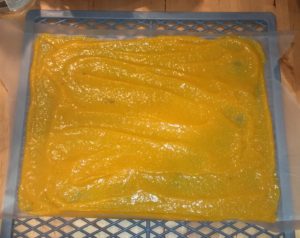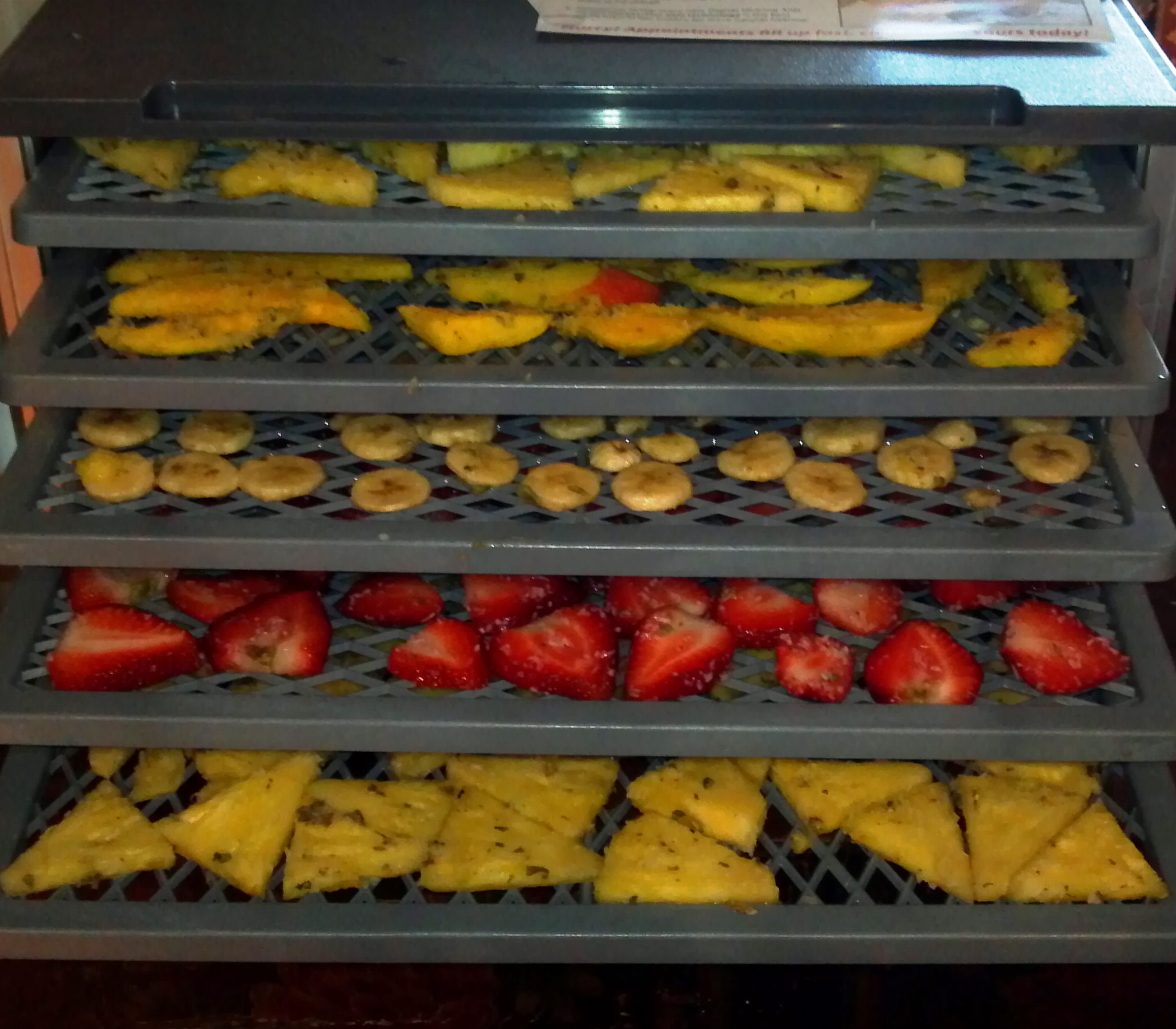Natural Fruity Snacks with No Preservatives & No Added Colors or Flavors
Fruit leather is a tasty dehydrated fruit snack enjoyed by kids (and adults) for its sweet-tart flavor and chewy texture. Known commonly by the trade names “Fruit Roll-Ups” or “Fruit by the Foot,” fruit leather is purported to be a healthy snack. But many commercial brands of fruit leather contain a load of preservatives, artificial colors, artificial flavors and added sugar. Fruit leather’s cousin, “fruit snacks,” contain all of the previous offenders and little, if any real fruit. Few organic fruit leather or fruit snack options exist, and those that can be found on the store shelves are pricey. Thankfully, fruit leather and dried fruit are easy and inexpensive to make, with or without a dehydrating machine.
The drying process preserves fruit nutrients and concentrates the flavor of the fruit. Dried fruit stores for a very long time, and homemade fruit leather is extremely easy to roll up to take with you for camping, hiking or lunches. Dehydrating fruit is also an economical way to preserve surplus fruit when it is in season.
The following are my favorite recipes for drying mangoes, pineapple, bananas and strawberries. Yum!
Tropical P ineapple Mango Fruit Leather
ineapple Mango Fruit Leather
Ingredients and Supplies
3 ripe mangoes, peeled & seeded (hint: leave some of the peel on the mango for added vitamins)
1 large ripe pineapple, peeled and diced
The juice of half a lemon (or 1 tsp bottled lemon juice)
1/2 C unsweetened shredded coconut
Optional: 1 whole vanilla bean, washed and chopped into 1″ sections
Dehydrator racks lined with wax paper or cookie sheets lined with parchment paper
Preparation
Before making the puree for the fruit leather, prepare your dehydrator racks or cookie sheets. If you will dehydrate in your oven, do not use wax paper, which melts. Use parchment paper with a light spray of cooking oil. If, on the other hand, you will dehydrate in a machine or in the great outdoors, wax paper works best for fruit leather.
To prevent the puree from running off of my racks, I like to fold the edges of the paper up at a right angle to form a lip around the outside edge (see photo.)
Instructions
1. Puree mango, pineapple and vanilla bean (optional) in a blender or food mill until smooth.
2. Place the puree in a bowl. Stir in the coconut and the lemon juice until well mixed.
3. Spread the puree in a 1/4″ thick square or rectangle on your dehydrator racks or cookie sheets.
1/4″ thick square or rectangle on your dehydrator racks or cookie sheets.
4. If using a dehydrator… place the racks into your machine and dry according to the manufacturer’s instructions. Turn the racks after 2-3 hours for even drying.
If using your oven… place the cookie sheets into the oven. Set the oven to its lowest temperature and dry the puree for several hours with the door cracked open. Keep a close eye on the fruit leather, and turn off the heat if it appears to be cooking rather than drying.
If drying outdoors in the sun… cover the cookie sheets with a screen or cheesecloth to protect the puree from debris and insects. Place in a
sunny location. Do not allow the screen or the cloth to touch the puree, or it will stick!
4. When the puree is dry and no longer sticky to the touch, lay it on the counter and cut it into long strips of your preferred width. I like to cut mine into strips that are 1″ wide and about 8″ long.
Use a clean pair of scissors or a pizza wheel to cut the strips.
Do not remove the paper from the back of the fruit leather. You will store the leather in the paper and remove it just prior to consumption.
5. Roll the strips into tight coils. Secure the ends with tape. For a more festive look or if you are making the rolls for a gift, tie a length of twine or ribbon around each coil.
6. Store the rolls in a cool, dry place in an air-tight container. I often store them in clear glass jars on my kitchen table where they make a pretty display as well as a handy, delicious snack.
Variations
Many different kinds of fruits can be substituted for the mangoes and pineapple. Apples, peaches, apricots, strawberries and bananas work particularly well. Melons taste bitter to me when dried, so I avoid using them. Citrus does puree into a thick enough mixture, but it could be added to other fruits for drying.
One of my favorite variations is 1 mango with a pound of strawberries, 1 banana, 1 tsp of sugar or honey and the juice of half a lemon. I add a little bit of sugar to this recipe because strawberries can taste sour when they are dried, but the sugar is certainly optional. Follow the directions for Pineapple Mango Fruit Leather.
Wax Paper or Parchment?
Should you use wax paper or baking parchment for drying fruit leather? Here are a few considerations:
Wax paper should only be used in a dehydrating machine or outdoors. It should never be used in an oven, as it is prone to melting. I find that it works better than parchment paper because fruit leather is less apt to stick to it than to parchment paper.
Baking parchment can be used to dehydrate in an oven, a dehydrating machine, or outdoors. Dried fruit may stick to it, but a light spritz of cooking oil will help fruit leather to release from it more easily.
Covering your fruit with cheesecloth or a screen is necessary for outdoor dehydrating to prevent debris and wildlife from contaminating your food. These materials are porous enough to allow moisture to escape and do not trap heat from the sun that may cook your fruit rather than drying it. Do not allow the screen or cloth to touch the top of your fruit or it will stick to it.
Tropical Dried Fruit Snacks
Som etimes, I prefer bite-size pieces of dried fruit to fruit leather, and this tropical recipe is my favorite!
etimes, I prefer bite-size pieces of dried fruit to fruit leather, and this tropical recipe is my favorite!
Ingredients and Supplies
1 Pineapple, 2 mangos, 1 lb strawberries and 3 bananas (peeled and chopped into uniform pieces)
Pure cane sugar (optional, to taste)
Dried basil flakes (Thai basil or lemon basil)
Unsweetened coconut flakes
Lemon juice
Cookie sheets lined with parchment paper (only if drying in an oven or in the sun) or dehydrator trays spritzed lightly with cooking oil spray
Instructions
1. In a medium-size bowl, mix together 2 TBSP cane sugar, 1 tsp basil flakes and 1 TBSP coconut flakes.
2. Prepare one type of fruit at a time. Cut fruit into thin slices (1/8″ to 1/4″) that are as uniform in size as you can make them so that they dry evenly.
3. Place the fruit in the bowl and stir gently to coat each piece with the sugar mixture. Squeeze the juice of half a lemon over the fruit and stir again.
4. Arrange the fruit in a single layer on the trays so that the pieces are not touching each other.
5. Repeat the preparation procedures for each type of fruit.
6. Dry the fruit in your dehydrator machine according to the manufacturer’s instructions. You can alternatively dry them in the sun, covered with screen or cheesecloth, or in the oven on its lowest temperature setting (see the instructions for fruit leather.)
7. Fruit is ready when it is completely dry to the touch, but still flexible (not crisp.) Check your fruit often, and remove smaller pieces which will dry faster than larger ones. Store dried fruit in an air-tight container in a cool, dry area.
Long-Term Storage
Dried fruit and fruit leather is a space-saving method of storing a lot of food in a small space. Prepared and stored properly, dried fruit will last months or even years. Here are three methods to store dried fruit for the long-term.
Freezing: Seal fruit in air-tight freezer bags to store for up to one year in the freezer. I recommend storing dried fruit in serving-size bags. Larger bags have to removed from and returned to the freezer in order to take out fruit for serving, and repetitive thawing and refreezing will reduce the quality and flavor of the fruit.
Food Saver: If you have a Food Saver machine, seal servings in air-tight Food Saver bags. Store in the pantry for several months or in the freezer for up to two years.
Air-Tight Containers with Oxygen Eaters: Seal dried fruit in an air-tight container with an oxygen eater to remove the air that can degrade the quality of your fruit. Dried fruit stored this way will last indefinitely.
Food Storage Resources
For short-term storage, keep dried fruit and fruit leather in easily accessible glass jars with lids.
For long-term storage, seal fruit in air-tight containers. Use a Food Saver machine to remove air from fruit stored in Food Saver bags. Dried fruit will keep in a Food Saver bag for several months in the pantry or two years in the freezer.
For Long-Term Emergency food storage, seal dried fruit in mylar bags that are air and moisture-resistant. Place the bags in a food-grade bucket that is BPA-free. Place an oxygen eater in the bucket and seal with a gamma lid. As long as the bucket remains closed and sealed, dried fruit stored this way will last indefinitely. However, to ensure freshness, I recommend rotating and replacing dried fruit storage annually.
More Dried Fruit and Fruit Leather Recipes
- How to Make Mango Fruit Leather (Without a Dehydrator!)
In this post, I’ll show you step-by-step how to make mango fruit leather without a dehydrator. All you need for this recipe is 2 mangoes–nothing else! - Homemade Fruit Leather Recipe | Homemade Fruit Roll-Ups | Two Peas & Their Pod
An easy recipe to make homemade fruit leather and homemade fruit roll-ups. - Apple and Raspberry Fruit Leather Recipe – CHOW
This apple and raspberry fruit leather recipe uses applesauce as a shortcut. - Dried Fruit Recipe : Alton Brown : Recipes : Food Network
Get this all-star, easy-to-follow Food Network Dried Fruit recipe from Alton Brown. - Recipes for drying your own fruit, dried fruit recipes
Many recipes for drying your own fruit. Also, candied fruit recipes. Or, if you don’t already have a dehydrator, you may purchase a food dehydrator from our large selection.


